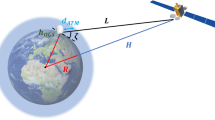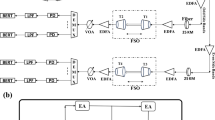Abstract
The performance of a reflective electro-absorption modulator transceiver is assessed in terms of both slope efficiency (SE) and responsivity in a radio-over-fiber network. Different biasing schemes are analyzed, specifically zero bias (passive solution), bias for maximum SE, and bias for maximum responsivity. Finally, two case studies on multiband orthogonal frequency division multiplexing ultra-wide band and Wi-Fi are presented, for which the optimum setup parameters are determined.












Similar content being viewed by others
References
Mitchell J (2004) Performance of OFDM at 5.8 GHz using radio over fibre link. IEEE Electron Lett 40(21):1353–1354
Tang PK, Ong LC, Alphones A, Luo B, Fujise M (2004) PER and EVM measurements of a radio-over-fiber network for cellular and WLAN system applications. IEEE J Lightwave Technol 22(11):2370–2376
Gomes N, Morant M, Alphones A, Cabon B, Mitchell J, Lethien C, Csörnyei M, Stöhr A, Iezekiel S (2009) Radio-over-fiber transport for the support of wireless broadband services [invited]. J Opt Netw 8(2):156–178
Jazayerifar M, Cabon B, Salehi J (2008) Transmission of multi-band OFDM and impulse radio ultra-wideband signals over single mode fiber. IEEE J Lightwave Technol 26(15):2594–2603
Sauer M, Kobyakov A, George J (2007) Radio over fiber for picocellular network architectures. IEEE J Lightwave Technol 25(11):3301–3320
Lim C, Nirmalathas A, Bakaul M, Gamage P, Lee K, Yang Y, Novak D, Waterhouse R (2010) Fiber-wireless networks and subsystem technologies. IEEE J Lightwave Technol 28(4):390–405
Jia Z, Yu J, Chang G (2006) A full-duplex radio-over-fiber system based on optical carrier suppression and reuse. IEEE Photonics Technol Lett 18(16):1726–1728
Chen L, Wen H, Wen S (2006) A radio-over-fiber system with a novel scheme for millimeter-wave generation and wavelength reuse for up-link connection. IEEE Photonics Technol Lett 18(19):2056–2058
Cox C (2004) Analog optical links: theory and practice. Cambridge University Press
Wake D, Johansson D, Moodie D (1997) Passive picocell: a new concept in wireless network infrastructure. IEEE Electron Lett 33(5):404–406
Stohr A, Kitayama K, Jager D (1999) Full-duplex fiber-optic RF subcarrier transmission using a dual-function modulator/photodetector. IEEE Trans Microwave Theor Tech 47(7):1338–1341
Kitayama K (2000) Architectural considerations of fiber-radio millimeter-wave wireless access systems. Fiber Integr Opt 19(2):167–186
Keiser G (2000) Optical fiber communications. Wiley, USA
PHY H, Standard M (2005) ECMA international ECMA-368
Chen Y, Zhang J, Jayalath A (2006) Multiband-ofdm uwb vs ieee802. 11n: system level design considerations. IEEE Veh Technol Conf 4:1972–1976
Oliveira J, Silva S, Pessoa L, Coelho D, Salgado H, Castro J (2010) UWB radio over perfluorinated GI-POF for low-cost in-building networks. In: IEEE Topical Meeting on Microwave Photonics, pp 317–320
IEEE (2009) IEEE Standard for Information technology–telecommunications and information exchange between systems–local and metropolitan area networks–specific requirements part 11: wireless LAN medium access control (MAC) and physical layer (PHY) specifications amendment 5: enhancements for higher throughput. IEEE Std 802.11n-2009, pp c1–502, 29
Corporation WN (2009) Product specifications of DNMA-92. An IEEE 802.11n a/b/g/n Mini-PCI module, version 1.6
Acknowledgements
We acknowledge funding from FCT and program POCTI/FEDER under the National Plan for Scientific Hardware Renewal with grant REEQ/1272/EEI/2005.
This work was supported in part by FCT under the project “Design and Optimisation of WDM Millimetre-Wave Fibre-Radio Systems” (PTDC/EEA-TEL/68974/2006) and EC Framework 7 (FP7) project DAPHNE (www.fp7daphne.eu) “Developing aircraft photonic networks” (grant ACP8-GA - 2009-233709). D. V. Coelho also acknowledges support from FCT through a PhD grant.
Author information
Authors and Affiliations
Corresponding author
Rights and permissions
About this article
Cite this article
Pessoa, L.M., Oliveira, J.M.B., Coelho, D.V. et al. Experimental evaluation of a R-EAM and noise impact analysis for UWB and Wi-Fi transmission in RoF networks. Ann. Telecommun. 68, 63–72 (2013). https://doi.org/10.1007/s12243-012-0312-0
Received:
Accepted:
Published:
Issue Date:
DOI: https://doi.org/10.1007/s12243-012-0312-0




